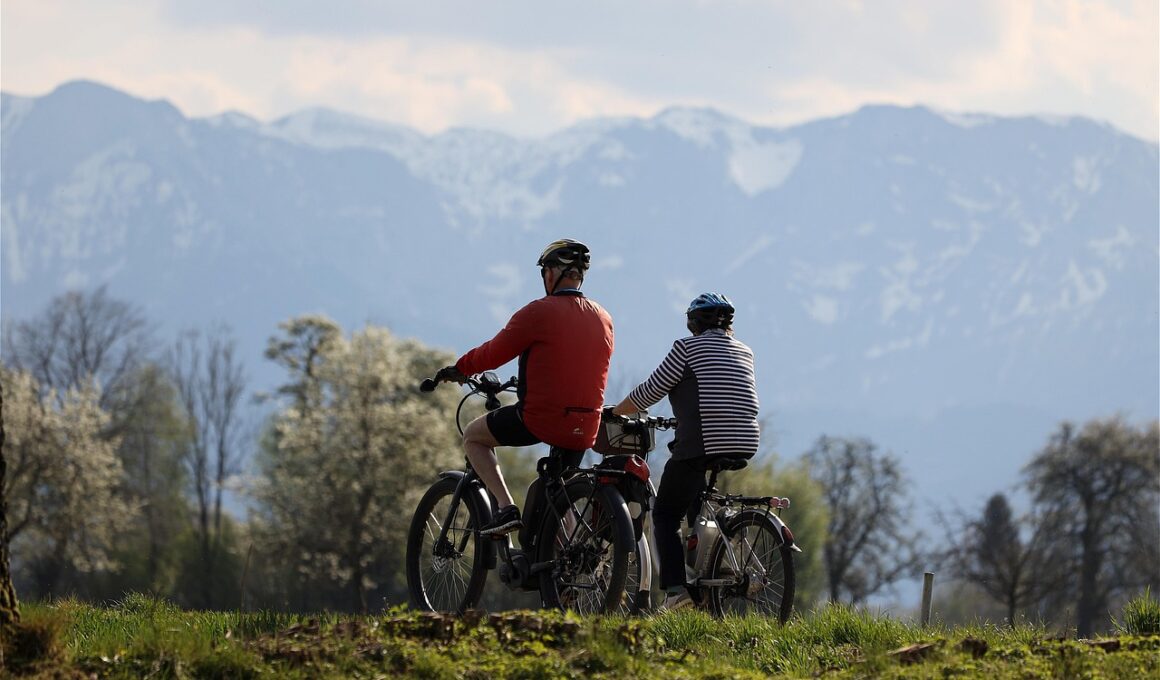How to Start Outdoor Fitness Activities Safely for Seniors
Participating in outdoor fitness activities can significantly enhance the quality of life for seniors. Engaging in such exercises not only improves physical health but also fosters social connections. However, it is essential to start safely. First, consult a healthcare provider for personalized advice, especially regarding any pre-existing conditions. They may recommend specific activities or restrictions. Selecting appropriate exercises that match physical capabilities and interests is key. Start slow with gentle activities, such as walking or stretching in a park. Pay attention to your body’s signals during and post-exercise, ensuring you rest when needed. Always wear suitable footwear to support joints and maintain stability. Regular hydration is vital; keep water handy. Schedule workouts in the morning or evening to avoid extreme heat, prioritizing safety over intensity. Consider joining community fitness groups focused on seniors, which can provide motivation and camaraderie. Diversifying activities helps maintain interest; explore yoga, tai chi, or leisurely hikes in nature. Embrace the outdoors, breathe fresh air, and enjoy a refreshed spirit through consistent outdoor exercise! Your journey to fitness can be enjoyable and rewarding when approached with care and consideration.
Before embarking on outdoor fitness activities, it’s crucial to have the right gear and equipment. Comfort is key, particularly for seniors, as the right equipment can minimize the risk of injury. Start with suitable, lightweight athletic shoes that provide proper support and cushioning. Depending on the activity, consider moisture-wicking clothing that keeps you cool and dry while exercising outdoors. Accessibility is another essential factor; walking sticks or mobility aids can enhance stability. Make sure to choose locations that have appropriate surfaces, avoiding uneven or rocky terrain that may cause accidents. Consider investing in a quality hat and sunglasses to protect your face and eyes from sunlight, along with sunscreen to prevent skin damage. If possible, find local parks or community centers that offer fitness classes for seniors; these facilities often provide equipment aimed at reducing injury risk. Participating in group activities can boost confidence while ensuring safety in numbers. Always inform someone of your planned activity route, particularly if venturing out alone. Prepare your body with a proper warm-up and cool-down routine to prevent strain or injury. Quality gear combined with safety in mind makes outdoor fitness for seniors enjoyable and effective.
Choosing Suitable Outdoor Activities
Choosing activities appropriate for seniors can greatly enhance the enjoyment of outdoor fitness. Low-impact exercises are usually recommended, focusing on flexibility, balance, and strength. Walking is an excellent starting point; it requires no special skills and can be done almost anywhere. Consider joining walking trails, clubs, or even nature hikes to add variety to your routine. Swimming offers a fantastic alternative, as doing it outdoors provides the benefits of both water therapy and exposure to fresh air. Gentle forms of yoga or tai chi can also be performed in parks, promoting balance and overall well-being. Activities like gardening allow for light physical exertion while providing relaxation and mental satisfaction as well. Dancing, whether in a class or just for fun at home, can provide heart-healthy aerobic exercise. Another option is cycling at a leisurely pace, which is easy on the joints while still offering cardiovascular benefits. Engage family or friends in these activities to enhance the enjoyment. Emphasizing socialization during fitness can provide additional motivation, as shared activities foster positive interactions and strengthen bonds.
To ensure safety while participating in outdoor fitness activities, it’s vital for seniors to monitor their physical responses. Regular check-ins with yourself about how you’re feeling during the activity can help avert overexertion. Common signals to pay attention to include tiredness, dizziness, and unusual joint or muscle pain. Always maintain an appropriate pace, allowing your body to adjust gradually to activity levels. Create a routine that includes rest days to give your body time to recover. Use a buddy system to engage in outdoor activities, enabling you to support one another through fitness journeys. Always have a fully charged phone for emergencies, and familiarize yourself with the location of the nearest help or facilities. If possible, carry a personal alert device when going out alone or far from accessible help. Be mindful of changes in weather, as seniors may be more susceptible to extremes. Invest in light rain gear or thermal shirts for colder days to ensure comfort. Planning and preparing for potential changes can contribute significantly to a positive outdoor exercise experience. A proactive mindset plays a crucial role in avoiding accidents.
Nutrition and Hydration for Outdoor Fitness
Maintaining good nutrition and hydration is essential for seniors engaging in outdoor fitness activities. A balanced diet contributes significantly to energy levels, particularly when exercising in fresh air. Focus on whole foods, including fruits, vegetables, lean proteins, and whole grains. These food sources provide the necessary nutrients that support sustained energy levels during outings. It’s important to plan meals around your activity schedule; consider eating a light snack before exercising, ensuring it’s rich in carbohydrates for energy. Always remember to hydrate adequately, especially during warmer months. Keeping a water bottle handy encourages seniors to drink regularly and to avoid dehydration. Besides plain water, consider incorporating oral rehydration solutions in extreme heat to maintain electrolyte balance. Nutrition doesn’t just support physical health; it also impacts mood and performance during outdoor activities. Consider scheduling regular meals and snacks to maintain energy levels throughout the day. To simplify meal preparation, try batch cooking on quieter days. Providing your body with proper nutrition enhances physical endurance and keeps spirits uplifted during outdoor adventures, allowing for an enriching participation in fitness activities.
Creating a supportive environment is important for seniors aiming to maintain outdoor fitness activities. Joining local clubs or community groups specialized for seniors can provide connection and motivation. Many organizations offer tailored fitness courses focusing on balance, strength, and social elements. Engaging with peers doing similar outdoor activities can foster friendships, making exercise enjoyable rather than obligatory. It’s helpful to locate nearby parks, recreational centers, or fitness trails designed for seniors to maintain accessibility. Inform family members or friends about your fitness goals; their support can help keep you accountable. Virtual communities are also valuable; look for online groups dedicated to senior fitness that share tips, experiences, and encouragement. Many seniors find companionship through fitness enhances their commitment to these activities. During outdoor excursions, always schedule social moments, like a picnic after walking. This encourages participation and creates cherished moments that motivate further involvement. Remember, the journey is just as important as the destination when enjoying outdoor activities. Supportive relationships and communities can help you thrive on the road to fitness, enhancing both physical health and social well-being.
Embracing Outdoor Fitness: Final Thoughts
In summary, embracing outdoor fitness is an empowering experience for seniors. By considering safety, proper gear, suitable activities, nutrition, and support, seniors can foster a healthier lifestyle. Remember, the journey towards fitness does not need to be rushed; progress at a pace that feels comfortable. Engage regularly with outdoor exercises, while always listening to one’s body. Enjoying nature and being active is beneficial to physical and mental health. Prioritize activities that resonate personally; this connection will make the experience more fulfilling. Document achievements to visualize progress, capturing moments through photographs or journaling. Set realistic and achievable goals aiming for long-term satisfaction rather than short-term results. Regular health check-ups can adapt fitness plans according to evolving needs, ensuring ongoing safety. Maintain an open dialogue with loved ones about fitness journeys, as sharing experiences often leads to encouragement and deeper bonding. Above all, focus on celebrating small victories; every step outdoors is a step towards improved well-being. Enjoy the process of regular outdoor fitness activities, as these provide wonderful opportunities to connect with nature while enhancing personal physical capabilities!
Outdoor fitness activities can be a vital aspect of a senior’s healthy lifestyle. With the right approach, they will strengthen both the body and mind, contributing positively to their overall well-being. It’s crucial to prioritize safety and enjoyment. This multifaceted approach allows seniors to engage fully in their communities while benefitting from nature’s soothing properties. Embrace this opportunity to enhance physical health and enjoy the outdoors.


